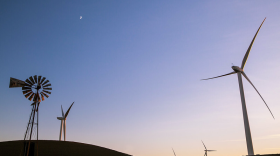Several thousand people came together in Elko over the weekend to celebrate the 36th annual National Cowboy Poetry Gathering. Folklife aficionados came from all corners of the country; they shared music, stories and spoken word.
In addition to the lively arts scene, a group of cowboys presented on how ranchers can manage cattle to mitigate climate change.
"It’s pretty big, but I’m trying to save the world with cows," said David Voth, president of the Northeastern Nevada Stewardship Group. The NNSG is made up of ranchers and government agencies that collaborate to implement sustainable agricultural practices.
Voth helped organize a panel at the Cowboy Poetry Gathering on regenerative agriculture. The approach takes a holistic look at any given farm operation and aims to create a sustainable plan for the animals and environment, and the humans’ finances, too.
For Voth’s ranch, that meant retraining the cattle’s grazing habits and rotating the herds more frequently.
"We do a lot of stockmanship-type events, where we’re going around the country introducing this different way to take care of cattle, where we can bunch them up [and] rekindle this herd instinct, kind of like the animals you’d see on the savanna, where there are large groups of cattle, all hanging together and moving around very frequently," Voth said.
This strategy helps keep cows from eroding sensitive riverbeds and Voth said when the cows trim the grass, it actually helps the grass grow fuller. The cow manure boosts the grass growth, which ultimately absorbs carbon dioxide from the atmosphere.
Some new research supports this concept.
"A cow is really this, you can think of it as this compost vat … in a brittle environment, it’s this perfect depositor of compost and life back into the soil. If managed properly, their hooves can break the capping of the soil, their dung and urine add nutrients and, literally, biology back into the soil, and then it becomes that fertile ground for new life to come," said Abbey Smith, a cattle rancher in the Northern Sierra.
Smith and her husband consult with farmers on regenerative agriculture and presented their work at the Cowboy Poetry Gathering.
KUNR Contributor Kathleen Masterson manages the Hitchcock Project for Visualizing Science, which is run by the Reynolds School of Journalism. She's also a cohost on our podcast Science Distilled.





